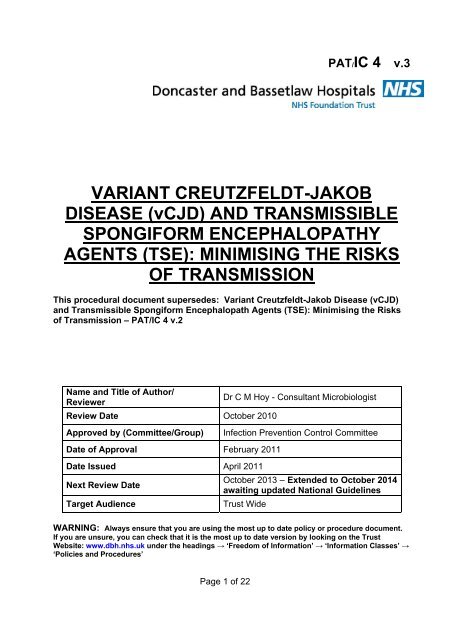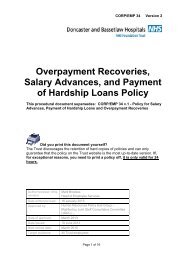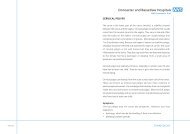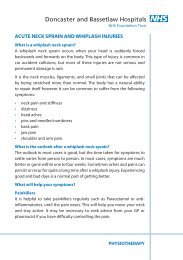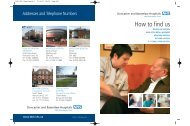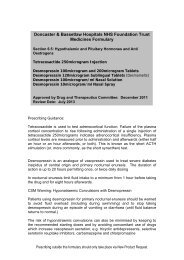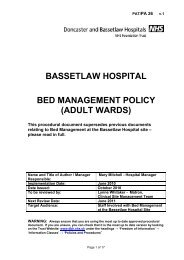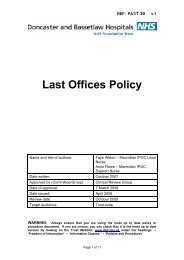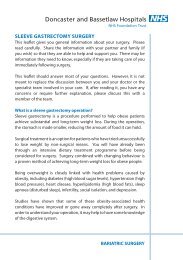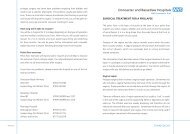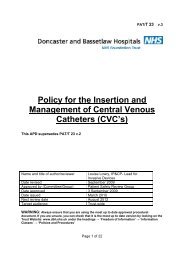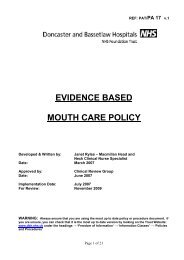VARIANT CREUTZFELDT-JAKOB DISEASE (vCJD) AND ...
VARIANT CREUTZFELDT-JAKOB DISEASE (vCJD) AND ...
VARIANT CREUTZFELDT-JAKOB DISEASE (vCJD) AND ...
You also want an ePaper? Increase the reach of your titles
YUMPU automatically turns print PDFs into web optimized ePapers that Google loves.
PAT/IC 4 v.3<br />
<strong>VARIANT</strong> <strong>CREUTZFELDT</strong>-<strong>JAKOB</strong><br />
<strong>DISEASE</strong> (<strong>vCJD</strong>) <strong>AND</strong> TRANSMISSIBLE<br />
SPONGIFORM ENCEPHALOPATHY<br />
AGENTS (TSE): MINIMISING THE RISKS<br />
OF TRANSMISSION<br />
This procedural document supersedes: Variant Creutzfeldt-Jakob Disease (<strong>vCJD</strong>)<br />
and Transmissible Spongiform Encephalopath Agents (TSE): Minimising the Risks<br />
of Transmission – PAT/IC 4 v.2<br />
Name and Title of Author/<br />
Reviewer<br />
Review Date October 2010<br />
Dr C M Hoy - Consultant Microbiologist<br />
Approved by (Committee/Group)<br />
Infection Prevention Control Committee<br />
Date of Approval February 2011<br />
Date Issued April 2011<br />
Next Review Date<br />
Target Audience<br />
October 2013 – Extended to October 2014<br />
awaiting updated National Guidelines<br />
Trust Wide<br />
WARNING: Always ensure that you are using the most up to date policy or procedure document.<br />
If you are unsure, you can check that it is the most up to date version by looking on the Trust<br />
Website: www.dbh.nhs.uk under the headings → ‘Freedom of Information’ → ‘Information Classes’ →<br />
‘Policies and Procedures’<br />
Page 1 of 22
PAT/IC 4 v.3<br />
<strong>VARIANT</strong> <strong>CREUTZFELDT</strong>-<strong>JAKOB</strong> <strong>DISEASE</strong> (<strong>vCJD</strong>) <strong>AND</strong><br />
TRANSMISSIBLE SPONGIFORM ENCEPHALOPATHY AGENTS (TSE):<br />
MINIMISING THE RISKS OF TRANSMISSION<br />
POLICY AMENDMENT FORM<br />
Version Date Brief Summary of Changes Author<br />
3 October 2010 • All sections re-written in line with<br />
National Guidelines<br />
Dr C M Hoy<br />
2 April 2007 Policy re-written in conjunction with National<br />
Guidelines<br />
Infection<br />
Control Team<br />
Page 2 of 22
PAT/IC 4 v.3<br />
<strong>VARIANT</strong> <strong>CREUTZFELDT</strong>-<strong>JAKOB</strong> <strong>DISEASE</strong> (<strong>vCJD</strong>) <strong>AND</strong> TRANSMISSIBLE SPONGIFORM<br />
ENCEPHALOPATHY AGENTS (TSE): MINIMISING THE RISKS OF TRANSMISSION<br />
Paragraph<br />
Page No<br />
CONTENTS PAGE<br />
1. Aim 4<br />
2. Duties 4<br />
3. Education 4<br />
4. Introduction 4<br />
5. Hospital Care of Patients 5<br />
6. Sample Taking and Other Invasive Medical Procedures 6<br />
7. Spillages 7<br />
8. Clinical Waste 7<br />
9. Childbirth 9<br />
10. Surgical and Endoscopic Procedures 9<br />
10.1 Assessment of CJD / <strong>vCJD</strong> risk 9<br />
10.2 Surgical and endoscopic procedures and instrument management 14<br />
11. After Death 20<br />
12. References 21<br />
Appendix 1 - Algorithm chart for precautions for reusable instruments for surgical<br />
procedures on patients with, or “at increased risk” of, CJD, <strong>vCJD</strong><br />
and other human prion diseases<br />
22<br />
Page 3 of 22
PAT/IC 4 v.3<br />
<strong>VARIANT</strong> <strong>CREUTZFELDT</strong>-<strong>JAKOB</strong> <strong>DISEASE</strong> (<strong>vCJD</strong>) <strong>AND</strong> TRANSMISSIBLE<br />
SPONGIFORM ENCEPHALOPATHY AGENTS (TSE): MINIMISING THE RISKS OF<br />
TRANSMISSION<br />
1. AIM<br />
The aim of the policy is to provide advice on safe working practices to minimise the risk of<br />
transmitting transmissible spongiform encephalopathies (TSEs) in a healthcare setting.<br />
2. DUTIES<br />
This policy covers infection prevention and control management issues for Trust staff,<br />
including:-<br />
• Employees<br />
• Volunteers<br />
• Agency/Locum/Bank Staff<br />
• Contractors whilst working on the Trust premises<br />
Each individual member of staff, volunteer or contracted worker within the Trust is<br />
responsible for complying with the standards set out in the Policy. They need to be aware<br />
of their personal responsibilities in preventing the spread of infection. It is the responsibility<br />
of Directors and Managers to ensure compliance with this standard.<br />
3. EDUCATION<br />
Staff will receive instructions and direction regarding infection prevention and control<br />
practice and information from a number of sources:-<br />
• Trust Induction<br />
• Trust Policies and Procedures available on the intranet<br />
• Ward/departmental/line managers<br />
• As part of the mandatory infection control education sessions that Trust staff attend.<br />
• Infection Prevention and Control Educational displays/ posters<br />
• Trust Infection Prevention and Control Team<br />
• Ward link practitioners<br />
4. INTRODUCTION<br />
Transmissible spongiform encephalopathies (TSEs) are rare, fatal degenerative diseases<br />
affecting the central nervous system. The human TSEs are:<br />
• Idiopathic diseases: sporadic Creutzfeldt Jakob disease (CJD) and sporadic fatal<br />
insomnia<br />
• Familial diseases: familial CJD, Gerstmann-Sträussler-Scheinker (GSS) disease<br />
and fatal familial insomnia<br />
• Acquired diseases: Human agents: Kuru and iatrogenic CJD<br />
Bovine agent: variant CJD<br />
Page 4 of 22
PAT/IC 4 v.3<br />
TSEs are caused by unconventional infectious agents, currently thought to be infectious<br />
proteins known as prions. The world-wide incidence of TSEs is about 1 per million people<br />
each year. The most common form is sporadic CJD, the cause of which is unknown,<br />
although genetic factors influence disease susceptibility. Around 10% of cases occur as<br />
inherited familial diseases, which have a genetic origin associated with mutations in the<br />
prion protein gene.<br />
It is known that transmission of CJD can occur in specific situations associated with<br />
medical interventions (known as iatrogenic infections). Worldwide, cases of iatrogenic CJD<br />
have been associated with administration of hormones prepared from human pituitary<br />
glands and dura mater preparations and one definite case has been associated with a<br />
corneal graft (it is possible that corneal tissue was contaminated with posterior segment<br />
tissue during processing). Iatrogenic transmission has also been identified following<br />
neurosurgical procedures with inadequately decontaminated instruments.<br />
Variant CJD (<strong>vCJD</strong>) was first recognised in 1996 and the agent responsible is biologically<br />
indistinguishable from that responsible for Bovine Spongiform Encephalopathy (BSE) in<br />
cattle. Since 2003, four cases of presumed person-to-person spread of <strong>vCJD</strong> infection via<br />
blood transfusion of non-leucodepleted red blood cells have been reported in the UK and a<br />
probable case via plasma products.<br />
In sporadic CJD, most patients present in late middle age with rapidly progressive<br />
dementia and focal neurological signs including ataxia, myoclonus, visual disturbances and<br />
rigidity. Variant CJD generally affects young adults, with initially psychiatric and sensory<br />
abnormalities followed by ataxia, myoclonus and dementia.<br />
TSE agents exhibit an unusual resistance to conventional chemical and physical<br />
decontamination methods, including disinfectants, standard autoclaving and ionising and<br />
UV irradiation. Effective cleaning is therefore of great importance in the removal of these<br />
agents.<br />
5. HOSPITAL CARE OF PATIENTS<br />
There is no evidence that normal social or routine clinical contact of a CJD/<strong>vCJD</strong> patient<br />
presents a risk to healthcare workers, relatives and others. Isolation of patients with<br />
CJD/<strong>vCJD</strong> is not necessary, and they can be nursed in an open ward using standard<br />
infection control precautions (PAT/IC 19 - Standard Infection Control Precautions Policy).<br />
In sporadic CJD, abnormal prion protein appears to be restricted to the central nervous<br />
system in patients with clinical disease. However, in patients with clinical <strong>vCJD</strong>, abnormal<br />
prion protein has been detected in various lymphoid tissues including tonsils, spleen,<br />
gastrointestinal lymphoid tissue (appendix and rectum), lymph nodes, thymus and adrenal<br />
glands. Abnormal prion protein has also been detected in lymphoid tissue within the<br />
appendix prior to clinical onset of <strong>vCJD</strong>.<br />
Page 5 of 22
PAT/IC 4 v.3<br />
Although cases of CJD/<strong>vCJD</strong> have been reported in healthcare workers, there have been<br />
no confirmed cases linked to occupational exposure. However, it is prudent to take a<br />
precautionary approach. The highest potential risk is from exposure to high infectivity<br />
tissues through direct inoculation, for example as a result of sharps injury, puncture wound<br />
or contamination of broken skin, and mucous membrane exposure. Healthcare personnel<br />
who work with patients with definite/probable/possible CJD/<strong>vCJD</strong>, or with potentially<br />
infected tissues should be appropriately informed about the nature of the risk and relevant<br />
safety procedures. Compliance with standard infection control precautions will help to<br />
minimise risks from occupational exposure. (PAT/IC 8 - Policy for the Safe Use and<br />
Disposal of Sharps)<br />
When considering measures to prevent transmission in a healthcare setting, it is useful to<br />
distinguish between symptomatic patients, who fulfill the diagnostic criteria for definite,<br />
probable or possible CJD or <strong>vCJD</strong> and patients with no clinical symptoms, who are “at<br />
increased risk” of developing one of these diseases because of their medical or family<br />
history. A number of patients have been identified as “at increased risk” of CJD or <strong>vCJD</strong> on<br />
the recommendation of the CJD Incidents Panel due to their medical or family history - the<br />
patient groups are outlined in Table 1. Recipients of ocular transplants, including corneal<br />
transplants, are not considered to be “at increased risk” of CJD/<strong>vCJD</strong>.<br />
All people who are “at increased risk” of CJD/<strong>vCJD</strong> are asked to help prevent any further<br />
transmission to other patients by:<br />
• Not donating blood<br />
• Not donating organs or tissues including bone, marrow, sperm, eggs or breast milk<br />
• If undergoing medical,dental or surgical procedures – tell whoever is treating them<br />
beforehand so appropriate arrangement can be made for instruments<br />
GPs are asked to record their patient’s CJD/<strong>vCJD</strong> risk status and should include this<br />
information in any referral letter should the patient require invasive medical, surgical or<br />
dental procedures.<br />
6. SAMPLE TAKING <strong>AND</strong> OTHER INVASIVE MEDICAL PROCEDURES<br />
When taking samples or performing other invasive procedures, the possible infectivity of<br />
the tissue(s) involved must be considered, and if necessary, suitable precautions taken. It<br />
is important to ensure that only trained staff, who are aware of the hazards, carry out<br />
invasive procedures that may lead to contact with medium or high risk tissue. Body<br />
secretions, body fluids (including saliva, blood, CSF and excreta) are all low risk for<br />
CJD/<strong>vCJD</strong>. It is therefore likely that the majority of samples taken or procedures performed<br />
will be low risk. Contact with small volumes of blood (including inoculation injury) is<br />
considered low risk, though it is known that transfusion of large volumes of blood and<br />
blood components may lead to <strong>vCJD</strong> transmission.<br />
Blood and body fluid samples from patients with or “at increased risk” of CJD/<strong>vCJD</strong> should<br />
be handled with standard infection control precautions as for any other patient i.e. use of<br />
disposable gloves and eye protection where splashing may occur, avoidance of sharps<br />
Page 6 of 22
PAT/IC 4 v.3<br />
injuries and the safe disposal of sharps (PAT/IC 8 - Policy for the Safe Use and Disposal of<br />
Sharps and contaminated waste CORP/HSFS 17 - Waste Policy). Single use disposable<br />
equipment should be used wherever practicable.<br />
Samples from patients with or “at increased risk” of CJD/<strong>vCJD</strong> should be marked with a<br />
“Biohazard / Danger of Infection” label and the laboratory informed in advance that a<br />
sample is being sent. TSE agents are classified as Hazard Group 3 – see PAT/IC 11 –<br />
Collection and Handling of Pathology Specimens, for appropriate packaging and transport<br />
of pathology samples.<br />
Guidance for pathologists and pathology laboratories handling tissues from patients with,<br />
or at risk of, CJD or <strong>vCJD</strong> can be found at “Transmissible spongiform encephalopathy<br />
agents : Safe working and the prevention of infection” - Annex K. Department of Health<br />
7. SPILLAGES<br />
Standard infection control precautions should be followed for any spillages (including blood<br />
and CSF), which should be cleared up as quickly as possible, keeping contamination to a<br />
minimum. Disposable gloves and an apron should be worn. For spillages of large volumes<br />
of liquid, absorbent material should be used to absorb the spillage. Standard disinfection<br />
for spillages (eg. 10,000ppm chlorine-releasing agent) should be used to decontaminate<br />
the surface after the spillage has been removed. It should be noted that none of the<br />
methods currently suggested by WHO for prion inactivation are likely to be fully effective.<br />
Any waste (including cleaning tools such as mop heads and PPE worn) should be<br />
disposed of as clinical waste – see below (PAT/IC 18 - Policy for Spillage of Blood and<br />
Other Body Fluids, CORP/HSFS 17 - Waste Policy).<br />
8. CLINICAL WASTE<br />
The ACDP TSE Working Group have considered the disposal of clinical waste, and have<br />
agreed that tissues, and contaminated materials such as dressings and sharps, from<br />
patients with, or “at increased risk” of CJD/<strong>vCJD</strong> should be disposed of as in the following<br />
table:<br />
Diagnosis of CJD High or medium risk Low risk tissue and body fluids**<br />
tissue *<br />
Definite Incinerate Normal clinical waste disposal<br />
Probable Incinerate Normal clinical waste disposal<br />
“At increased risk” Incinerate Normal clinical waste disposal<br />
* - See Table 3 below and Transmissible Spongiform Encephalopathy Agents: Safe working<br />
Practice ant the Prevention of Infection - Annex A1<br />
** - Tissues and materials deemed to be low risk include body fluids such as urine, saliva, sputum,<br />
blood and faeces. Blood from <strong>vCJD</strong> patients is considered low risk except when transfused in large<br />
volumes<br />
Page 7 of 22
PAT/IC 4 v.3<br />
Table 1. Categorisation of patients by risk<br />
Symptomatic<br />
patients<br />
• Patients who fulfill the diagnostic criteria for definite, probable or possible CJD or<br />
<strong>vCJD</strong> (cases are classified by a neurologist from the National CJD Surveillance<br />
Unit – see Transmissible spongiform encephalopathy agents : Safe working and<br />
the prevention of infection – Annex B)<br />
• Patients with neurological disease of unknown aetiology who do not fit the criteria<br />
for possible CJD or <strong>vCJD</strong> but where the diagnosis of CJD is being actively<br />
considered<br />
Patients “at<br />
increased<br />
risk” from<br />
genetic forms<br />
of CJD<br />
• Individuals who have been shown by specific genetic testing to be at significant<br />
risk of developing CJD<br />
• Individuals who have a blood relative known to have a genetic mutation<br />
indicative of genetic CJD;<br />
• Individuals who have had two or more blood relatives affected by CJD or other<br />
prion disease.<br />
Patients<br />
identified as<br />
“at increased<br />
risk” of<br />
CJD/<strong>vCJD</strong><br />
through<br />
iatrogenic<br />
exposures<br />
• Recipients of hormone derived from human pituitary glands, e.g. growth hormone,<br />
gonadotrophin. In the UK, the use of human-derived gonadotrophin was<br />
discontinued in 1973 and use of cadaver-derived human growth hormone was<br />
banned in 1985. However, use of human-derived products may have continued in<br />
other countries after these dates.<br />
• Individuals who underwent intradural neurosurgical or spinal procedures before<br />
August 1992. These patients may have received a graft of human-derived dura<br />
mater and should be treated as “at increased risk” unless evidence can be<br />
provided that human-derived dura mater was not used. Patients who received a<br />
graft of human-derived dura mater before August 1992 are “at increased risk” of<br />
transmission of sporadic CJD<br />
• Individuals who have had surgery using instruments that had been used on<br />
someone who went on to develop CJD/<strong>vCJD</strong>, or was “at increased risk” of<br />
CJD/<strong>vCJD</strong><br />
• Individuals who have received an organ or tissue from a donor infected with<br />
CJD/<strong>vCJD</strong> or “at increased risk” of CJD/<strong>vCJD</strong><br />
• Individuals who have been identified prior to high risk surgery as having received<br />
blood or blood components from 80 or more donors since January 1980<br />
• Individuals who have received blood from someone who went on to develop <strong>vCJD</strong><br />
• Individuals who have given blood to someone who went on to develop <strong>vCJD</strong><br />
• Individuals who have received blood from someone who has also given blood to a<br />
patient who went on to develop <strong>vCJD</strong><br />
• Individuals who have been treated with certain implicated UK sourced plasma<br />
products between 1980 and 2001<br />
Page 8 of 22
PAT/IC 4 v.3<br />
9. CHILDBIRTH<br />
In the event that a patient with, or “at increased risk “ of CJD or <strong>vCJD</strong> becomes pregnant, it<br />
is important to ensure that patient confidentiality is properly maintained, and that any action<br />
taken to protect public health does not prejudice individual patient care.<br />
Childbirth should be managed using standard infection control precautions. The placenta<br />
and other associated materials and fluids are designated as low risk tissues, and should be<br />
disposed of as clinical waste, unless they are needed for investigation.<br />
10. SURGICAL <strong>AND</strong> ENDOSCOPIC PROCEDURES<br />
The CJD Incidents Panel has identified a number of individuals or groups who are at<br />
increased risk of CJD or <strong>vCJD</strong>. Arrangements should be in place to ensure that patients<br />
who have been notified that they are at increased risk of CJD/<strong>vCJD</strong> are identified before<br />
surgery or endoscopy to allow appropriate infection control procedures to be followed.<br />
Healthcare staff conducting pre-surgery assessments should receive instruction and/or<br />
training necessary to understand the reasons for answering the questions below and<br />
reassure patients and provide further information if needed . Information for patients is<br />
available from the CJD Incidents Panel website at:<br />
http://www.hpa.org.uk/CJDIncidentsPanel<br />
Also see “Transmissible spongiform encephalopathy agents : Safe working and the<br />
prevention of infection” - Annex J. Appendix B. Department of Health<br />
10.1 Assessment of CJD / v CJD risk<br />
i) Recommendation for all surgery and endoscopy patients<br />
All patients about to undergo any elective or emergency surgical or endoscopic procedure<br />
should be asked the question:<br />
“Have you ever been notified that you are at increased risk of CJD or <strong>vCJD</strong> for<br />
public health purposes?”<br />
Patient’s<br />
response<br />
No<br />
Yes<br />
Action<br />
Surgery or endoscopy should proceed using normal infection control<br />
procedures unless the procedure is likely to lead to contact with high risk<br />
tissue.<br />
Ask the patient to explain further – response should be recorded in medical<br />
notes.<br />
Special infection control precautions should be taken for all surgery or<br />
endoscopy involving contact with medium or high infectivity tissues (see<br />
below) and the Infection Prevention and Control team consulted for advice.<br />
Page 9 of 22
PAT/IC 4 v.3<br />
Unable to<br />
respond<br />
Surgery or endoscopy should proceed using normal infection control<br />
procedures unless the procedure is likely to lead to contact with high risk<br />
tissue. If this is the case, follow additional recommendations for high risk<br />
procedures – see below<br />
ii)<br />
Additional recommendations for surgery and neuroendoscopy which may<br />
involve contact with high risk tissue<br />
These additional recommendations are only applicable to those assessing patients for<br />
neurosurgical and posterior ophthalmic surgical procedures and intradural neuroendoscopic<br />
procedures.<br />
• Posterior segment eye surgery or procedure is defined as any surgery or procedure<br />
that involves potential contact with the posterior hyaloid face, retina, retinal pigment<br />
epithelium, choroid, subretinal fluid or optic nerve. Due to the high incidence of<br />
subretinal fluid drainage performed either intentionally or inadvertently during scleral<br />
buckling surgery, this form of surgery is considered as posterior segment surgery.<br />
See Transmissible spongiform encephalopathy agents : Safe working and the prevention<br />
of infection” - Annex L. for a list of posterior segment eye surgeries.<br />
As well as asking patients whether they have been notified as being at increased risk of<br />
CJD/<strong>vCJD</strong>, clinicians assessing patients for procedures that involve contact with high risk<br />
tissues should ask supplementary questions outlined in Table 2. Tissues assumed or<br />
proven to have high level infectivity for CJD or <strong>vCJD</strong> are:<br />
• Brain, spinal cord, dura mater, cranial nerves (entire optic nerve but only intracranial<br />
component other cranial nerves), cranial nerve ganglia, posterior eye (specifically,<br />
posterior hyaloid face, retina, retinal pigment epithelium, choroid, subretinal fluid,<br />
optic nerve) and pituitary gland.<br />
See “Transmissible spongiform encephalopathy agents : Safe working and the prevention<br />
of infection” – Annex A1. Department of Health for further advice on tissue infectivity.<br />
Ophthalmic units with a mixed case load of anterior and posterior segment surgeries and<br />
procedures may wish to ask the questions in Table 2 to all their patients for practical<br />
reasons – this is a local decision.<br />
As a separate pool of new posterior segment surgical instruments should be used for<br />
children born since 1 January 1997, and who have not previously undergone high risk<br />
procedures, it is important to correctly and reliably identify these patients and ensure they<br />
have had no previous high risk surgery which may have exposed them to a risk of<br />
CJD/<strong>vCJD</strong>.<br />
Page 10 of 22
PAT/IC 4 v.3<br />
Table 2. CJD Risk Questions for patients undergoing elective or emergency<br />
surgical or neuro-endoscopic procedures likely to involve contact with<br />
tissues of potentially high level infectivity<br />
From “Transmissible spongiform encephalopathy agents : Safe working and the prevention of infection”<br />
Annex J.<br />
Question to Patient<br />
1 Have you a history of CJD or<br />
other prion disease in your<br />
family? If yes, please specify.<br />
2 Have you ever received<br />
growth hormone or<br />
gonadotrophin treatment?<br />
If yes, please specify:<br />
i) whether the hormone was<br />
derived from human pituitary<br />
glands<br />
ii) the year of treatment<br />
iii) whether the treatment<br />
was received in the UK or in<br />
another country<br />
3 Have you had surgery on<br />
your brain or spinal cord?<br />
Notes to Clinician<br />
Patients should be considered to be at risk from genetic<br />
forms of CJD if they have or have had:<br />
i) Genetic testing, which has indicated that they are at<br />
significant risk of developing CJD or other prion disease<br />
ii) A blood relative known to have a genetic mutation<br />
indicative of genetic JD or other prion disease<br />
iii) Two or more blood relatives affected by CJD or other<br />
prion disease<br />
Recipients of hormone derived from human pituitary<br />
glands eg growth hormone or gonadotrophin, have been<br />
identified as at increased risk of sporadic CJD.<br />
In the UK the use of human-derived growth hormone was<br />
discontinued in 1985 but human-derived products may<br />
have continued to be used in other countries.<br />
In the UK, the use of human-derived gonadotrophin was<br />
discontinued in 1973 but may have continued in other<br />
countries after this time.<br />
a) Patients who underwent intradural neurosurgical or<br />
spinal procedures before August 1992 may have<br />
received a graft of human-derived dura mater, and<br />
should be treated as at increased risk, unless evidence<br />
can be provided that human-derived dura mater was not<br />
used. Patients who received a graft of human-derived<br />
dura mater before 1992 are at increased risk of sporadic<br />
CJD but not <strong>vCJD</strong>.<br />
b) NICE guidance emphasises the need for a separate<br />
pool of new neuroendoscopes and reusable surgical<br />
instruments for high risk procedures on children born<br />
since 1st January 1997 and who have not previously<br />
undergone high risk procedures. These instruments and<br />
neuroendoscopes should not be used for patients born<br />
before 1st January 1997 or those who underwent high<br />
risk procedures using reusable instruments before<br />
implementation of this guidance<br />
Page 11 of 22
PAT/IC 4 v.3<br />
4 Since 1980 have you had<br />
any transfusions of blood or<br />
blood components (red cells,<br />
plasma, cryoprecipitate or<br />
platelets)?<br />
If yes have you either:<br />
i) received more than 50<br />
units of blood or blood<br />
components? or<br />
ii) received blood or blood<br />
components on more than 20<br />
occasions?<br />
Patients who have received blood from more than 80<br />
donors have been identified as at increased risk of <strong>vCJD</strong>.<br />
This does not include:<br />
• Autologous transfusion<br />
• Plasma products such as IVIG, albumin,<br />
coagulation factors and anti-D<br />
Further information is available from the HPA<br />
http://www.hpa.org.uk/<strong>vCJD</strong>presurgicalassessment<br />
Where possible, please<br />
provide the names of all<br />
hospitals where you received<br />
blood or blood components.<br />
iii) Emergency surgery or neuro-endoscopy which may involve contact with high<br />
risk tissue<br />
In the event that a patient about to have emergency surgery or neuro-endoscopy is unable<br />
to answer any questions, a family member or someone close to the patient should be<br />
asked the CJD risk questions set out in Table 2.<br />
If the family member is not able to provide a definitive answer to the CJD risk questions,<br />
the surgery or neuro-endoscopy should proceed but all instruments should be quarantined<br />
(see below) following the procedure. The patient’s GP should be contacted after the<br />
surgery or neuro-endoscopy and asked as to whether the patient is at increased risk of<br />
CJD or <strong>vCJD</strong> according to the questions set out in Table 2.<br />
See “Transmissible spongiform encephalopathy agents : Safe working and the prevention<br />
of infection” - Annex J. Department of Health for further advice<br />
iv)<br />
Additional actions during pre-surgery assessment for CJD/<strong>vCJD</strong> risk<br />
In addition to asking the CJD/<strong>vCJD</strong> risk questions the following actions should also be<br />
carried out before any surgical or endoscopic procedure involving contact with high risk<br />
tissue.<br />
The clinician undertaking the pre-surgery assessment should:<br />
• Check the patient’s medical notes and/or referral letter for any mention of CJD or<br />
<strong>vCJD</strong>.<br />
• Consider whether there is a risk that the patient may be showing early signs of CJD<br />
or <strong>vCJD</strong> ie. consider whether the patient may have an undiagnosed neurological<br />
disease involving cognitive impairment or ataxia.<br />
Page 12 of 22
PAT/IC 4 v.3<br />
Table 3. Actions to be taken following patient’s response to questions in Table 2<br />
Patient’s<br />
response<br />
No to all<br />
questions<br />
Yes to any<br />
of questions<br />
1,2 or 3<br />
Action<br />
Surgery or neuro-endoscopy can proceed using normal infection control<br />
procedures<br />
Further investigation should be undertaken to assess the nature of the<br />
patient’s CJD risk – and this assessment recorded in the patient’s notes.<br />
If the patient is found to be at increased risk of CJD or<strong>vCJD</strong>, or the risk<br />
status is unknown, special infection control precautions should be taken,<br />
including quarantining of instruments (see below) and the Infection<br />
Prevention and Control team consulted for advice.<br />
Also see “Transmissible spongiform encephalopathy agents : Safe working<br />
and the prevention of infection” - Annex J. Department of Health for further<br />
advice<br />
Yes to<br />
question 4<br />
A highly transfused <strong>vCJD</strong> risk assessment form (see “Transmissible<br />
spongiform encephalopathy agents : Safe working and the prevention of<br />
infection” - Annex J Appendix D. ) should be completed if<br />
• The patient has received more than 50 units of blood or blood<br />
components or<br />
• The patient has received blood or blood components on more than 20<br />
occasions<br />
The results of the risk assessment, including the number of transfusions to<br />
date, should be recorded in the patient’s medical notes.<br />
If the patient has received fewer than 80 donor exposures, the patient is<br />
not considered to be at increased risk of <strong>vCJD</strong>. Surgery or neuro-endoscopy<br />
can proceed using normal infection control procedures.<br />
If the patient has received 80 or more donor exposures, the patient is<br />
confirmed as “at increased risk” of <strong>vCJD</strong>. Special infection control<br />
precautions should be taken, including quarantining of instruments (see<br />
below) and the Infection Prevention and Control team consulted for advice.<br />
The highly transfused <strong>vCJD</strong> risk assessment form should be forwarded to<br />
the HPA CJD section.<br />
For further advice and guidance see “Transmissible spongiform<br />
encephalopathy agents : Safe working and the prevention of infection” -<br />
Annex J. Department of Health and Pre-surgical assessment for <strong>vCJD</strong> risk<br />
in neurosurgery and eye surgery units. Information for clinicians. HPA 2009<br />
Unable to<br />
respond<br />
See section 10.1 part iii - above<br />
Page 13 of 22
10.2 Surgical and Endoscopic Procedures and Instrument Management<br />
PAT/IC 4 v.3<br />
For all patients with or “at increased risk” of CJD or <strong>vCJD</strong>, the following precations should<br />
be taken for surgical procedures:<br />
• Wherever appropriate and possible the intervention should be performed in an<br />
operating theatre<br />
• Where possible, procedures should be performed at the end of a list to allow normal<br />
cleaning of theatre surfaces before the next session<br />
• Only the minimum number of healthcare personnel required should be involved<br />
• Protective clothing should be worn i.e. liquid repellant operating gown, over a plastic<br />
apron, gloves, mask and goggles or full-face visor:<br />
o For symptomatic patients, this protective clothing should be single use and<br />
disposed of in line with Trust waste policy CORP/HSFS 17 - Waste Policy<br />
o For patients “at increased risk” of CJD/<strong>vCJD</strong>, this protective clothing need<br />
not be single use and may be reprocessed.<br />
• Single-use disposable surgical instruments and equipment should be used where<br />
possible, and subsequently be destroyed by incineration<br />
• Effective tracking of re-usable instruments should be in place, so that instruments<br />
can be related to use on a particular patient<br />
i) Single use instruments<br />
The following should be taken into account when using single-use instruments:<br />
• The quality and performance of single-use instruments should be equivalent to<br />
those of reusable instruments, with appropriate procurement, quality control and<br />
audit mechanisms in place<br />
• Procurement should be quality, not cost based, with the minimum safe functional<br />
requirements of each instrument purchased being understood by the purchaser<br />
• An internal quality control process for faulty single use instruments, similar to that<br />
for reusable instruments, needs to be put in place<br />
• A CE mark is not necessarily a mark of quality of instruments<br />
ii)<br />
Handling of instruments not designated single-use<br />
Where single-use instruments are not available, the handling of re-usable instruments<br />
depends on:<br />
• How likely the patient is to be carrying the infectious agent ( the patient’s risk status)<br />
• Whether the patient has, or is “at increased risk” of CJD/<strong>vCJD</strong><br />
• How likely it is that infection could be transmitted by the procedure being carried out<br />
i.e.whether there is contact with tissues of high or medium infectivity.<br />
Table 4 sets out the actions to be taken for instruments used on patients with, or “at<br />
increased risk” of CJD/<strong>vCJD</strong>. These are also summarised in the algorithm in Appendix 1.<br />
Page 14 of 22
PAT/IC 4 v.3<br />
Table 4. Handling of instruments – patients with or “at increased risk” of CJD/<strong>vCJD</strong><br />
Adapted from “Transmissible spongiform encephalopathy agents : Safe working and the prevention of<br />
infection” – Part 4. Department of Health; Feb 2010<br />
Tissue infectivity<br />
High<br />
Definite or<br />
probable<br />
Status of patient<br />
Possible<br />
At increased<br />
risk<br />
Brain<br />
Single use<br />
Single use<br />
Single use<br />
Spinal cord<br />
Dura mater<br />
Cranial nerves, specifically the<br />
entire optic nerve and the<br />
intracranial components of the other<br />
cranial nerves<br />
Cranial ganglia<br />
Posterior eye, specifically the<br />
posterior hyaloid face, retina, retinal<br />
pigment epithelium, choroid,<br />
subretinal fluid and<br />
optic nerve<br />
or<br />
Destroy<br />
or<br />
Quarantine for<br />
re-use<br />
exclusively on<br />
the same<br />
patient<br />
or<br />
Quarantine<br />
pending<br />
diagnosis<br />
or<br />
Destroy<br />
or<br />
Quarantine for<br />
re-use<br />
exclusively on<br />
the same<br />
patient<br />
Pituitary gland<br />
Medium<br />
Spinal ganglia<br />
Single use<br />
Single use<br />
Single use<br />
Olfactory epithelium<br />
or<br />
or<br />
or<br />
Tonsil (<strong>vCJD</strong> only)<br />
Appendix (<strong>vCJD</strong> only)<br />
Destroy<br />
or<br />
Quarantine<br />
pending<br />
diagnosis<br />
Destroy<br />
or<br />
Spleen (<strong>vCJD</strong> only)<br />
Thymus (<strong>vCJD</strong> only)<br />
Adrenal gland (<strong>vCJD</strong> only)<br />
Lymph nodes and gut-associated<br />
lymphoid tissues (<strong>vCJD</strong> only)<br />
Quarantine for<br />
re-use<br />
exclusively on<br />
the same<br />
patient<br />
Quarantine for<br />
re-use<br />
exclusively on<br />
the same<br />
patient<br />
Low<br />
No special<br />
precautions<br />
No special<br />
precautions<br />
No special<br />
precautions<br />
Page 15 of 22
PAT/IC 4 v.3<br />
iii)<br />
Quarantining of surgical instruments<br />
Instruments that have been used on a possible CJD or <strong>vCJD</strong> patient must not be re-used,<br />
but may be quarantined until the diagnosis is confirmed. Instruments should be rinsed to<br />
remove gross soil, taking care to avoid splashing and generating aerosols. Reusable<br />
instruments should be allowed to airdry and placed in an impervious, rigid plastic<br />
container, sealed and labelled with the patient’s details, surgical procedure and the name<br />
of the responsible person (HSDU manager) and the box stored in a suitable designated<br />
place. Detailed guidance on the procedure is set out in “Transmission spongiform<br />
encephalopathy agents : safe working and the prevention of infection” - Annex E. If the<br />
case is confirmed as CJD or <strong>vCJD</strong>, the box and its contents should be disposed of by<br />
incineration. If a definitive alternative diagnosis is confirmed, the instruments may be<br />
removed from the box by the responsible person and reprocessed according to best<br />
practice and returned to use.<br />
iv)<br />
Decontamination of instruments<br />
Effective decontamination is key to reducing the risk of transmission of CJD/<strong>vCJD</strong> through<br />
surgery. TSE agents are particularly resistant to standard physical and chemical methods<br />
of inactivation and decontamination. Therefore, effective cleaning is of great importance in<br />
the removal of these agents. Most chemical disinfectants are ineffective at reducing<br />
infectivity and some, acting as protein fixatives, may stabilise the agent. Incineration is<br />
effective at removing the infective agent and eliminating infectivity. Autoclaving remains an<br />
important method of reducing infectivity, but cannot be relied upon to completely eliminate<br />
infectivity. For further information see “Transmissable spongiform encephalopathy agents:<br />
Safe working and the prevention of infection – Annex C”.<br />
Some complex and expensive equipment such as drills and operating microscopes may be<br />
prevented from being contaminated by using shields, guards or coverings, so that the<br />
entire item does not need to be destroyed. In this case, the drill bit, other parts in contact<br />
with high or medium risk tissues, and the protective coverings would need to be<br />
incinerated. However, in practice, it may be difficult to ensure effective protective covering<br />
and advice should be sought from clinical staff and the manufacturer to determine<br />
practicality.<br />
v) Managing CJD/<strong>vCJD</strong> risk in ophthalmology<br />
There has been one definite case of CJD transmission from corneal transplantation, and<br />
other probable or possible cases reported over the past two decades. There are no other<br />
known cases of ophthalmic surgery or diagnostic procedure having resulted in CJD<br />
transmission between patients. No detectable levels of abnormal prion protein have been<br />
found in cornea, sclera, iris, lens, ciliary body, vitreous or choroid. The ACDP TSE Working<br />
Group and its Ophthalmology Subgroup have proposed that anterior segment surgery or<br />
procedures are low risk for iatrogenic transmission.<br />
Page 16 of 22
PAT/IC 4 v.3<br />
Patients should be assessed for risk of CJD or <strong>vCJD</strong> before elective or emergency surgery<br />
– as above.<br />
NICE guidance http://www.nice.org.uk/nicemedia/pdf/ip/IPG196guidance.pdf. states that<br />
for high risk surgical procedures:<br />
• Steps should be taken to ensure that instruments that come into contact with high risk<br />
tissues do not move from one set to another.<br />
• Supplementary instruments that come into contact with high risk tissues should either<br />
be single-use or should remain with the set to which they have been introduced.<br />
• A separate pool of new neuroendoscopes and reusable surgical instruments for high<br />
risk procedures should be used for children born since 1 January 1997 and who have<br />
not previously undergone high risk procedures.<br />
For further advice on handling of instruments used in posterior segment eye surgery see<br />
“Transmissible spongiform encephalopathy agents : Safe working and the prevention of<br />
infection” – Annex L.<br />
The use of single use instruments (eg tonometer prisms) or contact lenses is<br />
recommended for use on those designated “at increased risk” of CJD or <strong>vCJD</strong>. The<br />
practice of single-use instruments or contact lenses for examination should be encouraged<br />
for other patients where cost and quality are acceptable. If re-usable instruments or contact<br />
lenses are used, it is imperative that they are cleaned and decontaminated in an<br />
acceptable and consistent way, in accordance with “Transmission spongiform<br />
encephalopathy agents : safe working and the prevention of infection” - Annex L. The<br />
practice of decontaminanting tonometers with alcohol wipes is not sufficient and may, in<br />
fact, fix prion material to the surface of the instrument.<br />
vi)<br />
Use of laser for tonsillectomy smoke plumes<br />
Some ENT surgeons may use laser techniques for tonsillectomy. There is no evidence of<br />
transmission of TSEs by the respiratory route. Any risk from smoke plumes is thought to be<br />
very low, but there are no data on <strong>vCJD</strong>.<br />
vii)<br />
Decontamination of Endoscopes<br />
The general procedures set out in MDA Device Bulletin MDA DB2002(05) and BSG<br />
Guidelines for Decontamination of Endoscopes for Gastrointestinal Endoscopy 2008,<br />
should be followed. Additional precautions for the decontamination of flexible endoscopes<br />
used in all patients with, or at risk of, CJD/<strong>vCJD</strong> (see Table 1) are recommended.<br />
Channel cleaning brushes and, if a biopsy has been taken, the valve on the<br />
biopsy/instrument channel port should be disposed of as clinical waste after each use.<br />
Single-use (disposable) biopsy forceps should be used routinely in all patients. The MDA<br />
Bulletin and BSG guidelines advice that endoscope accessories should be single-use<br />
wherever possible. It is essential to have systems that enable endoscopes, together with<br />
Page 17 of 22
PAT/IC 4 v.3<br />
all their detachable components, to be traced to the patients on whom they have been<br />
used.<br />
Endoscopes used for certain procedures in the CNS and nasal cavity in individuals with<br />
CJD/<strong>vCJD</strong>, or in whom the diagnosis is unclear, should be removed from use or<br />
quarantined pending diagnosis.<br />
Endoscopes , other than those used in the CNS and nasal cavity, which have been used<br />
for invasive procedures in individuals with or at risk of <strong>vCJD</strong> should be removed from use<br />
or quarantined to be re-used exclusively on the same individual if required. The principles<br />
for quarantining surgical instruments should be followed, except the endoscope should be<br />
fully cleaned and decontaminated, alone using an automated endoscope reprocessor<br />
(AER), immediately after use. For For further advice and a list of common flexible<br />
endoscopic procedures classified as invasive or non-invasive, see “Transmissible<br />
spongiform encephalopathy agents : Safe working and the prevention of infection” – Annex<br />
F. Endoscopy for inspection, in the absence of an invasive procedure, is deemed to be of<br />
low risk, providing decontamination of the endoscope is to approved standards.<br />
Aldehyde disinfectants with fixative qualities (such as glutaraldehyde and OPA) tend to<br />
stabilise rather than inactivate prions and should not be employed on flexible endoscopes<br />
used for any procedure on patients with, or at risk of CJD/<strong>vCJD</strong>.<br />
Following decontamination of the endoscope the automated endoscope reprocessor (AER)<br />
should be run through an empty cycle. Any solid waste remaining in the AER should be<br />
removed together with the outlet strainer and disposed of by incineration. Liquid waste<br />
should be disposed of safely by normal direct discharge from the AER. The usual selfdisinfect<br />
cycle should be run as per recommended routine. Endoscopic accessories and<br />
cleaning aids such as brushes should be disposed of by incineration.<br />
viii)<br />
Transrectal prostatic biopsy in men at risk of variant CJD<br />
Patients at risk of <strong>vCJD</strong> requiring transrectal biopsy should have the procedure performed<br />
by means of single use equipment that runs alongside (rather than through) the ultrasound<br />
probe. If the procedure is undertaken with equipment that has internal biopsy channels, the<br />
reusable components should be quarantined after decontamination. It must be accepted<br />
that this equipment would be unlikely to return to general use, except for dedicated re-use<br />
in the same patient. For further advice see “Alert to Urological Surgeons: Transrectal<br />
Prostatic Biopsy in Men at Risk of variant CJD”<br />
Page 18 of 22
PAT/IC 4 v.3<br />
Table 5. Summary of precautions advised for use of endoscopes<br />
Adapted from “Transmissible spongiform encephalopathy agents : Safe working and the prevention of<br />
infection” – Annex F. Department of Health Jan 2010<br />
Tissue infectivity<br />
High<br />
• Brain<br />
• Spinal cord<br />
Medium<br />
• Olfactory<br />
epithelium 2<br />
• Lymphoid tissue 3<br />
(<strong>vCJD</strong> only)<br />
Status of patient<br />
Symptomatic<br />
Definite/<br />
Possible/<br />
probable diagnosis unclear<br />
Single use<br />
or<br />
Quarantine 1<br />
pending diagnosis<br />
Single use<br />
or<br />
Destroy after use<br />
Single use<br />
or<br />
Destroy after use<br />
Low/none detectable<br />
• All other tissues 4 No special<br />
precautions<br />
Single use<br />
or<br />
Quarantine 1<br />
pending diagnosis<br />
No special<br />
precautions<br />
Asymptomatic<br />
At risk<br />
iatrogenic/familial<br />
Single use<br />
or<br />
Destroy after use<br />
or<br />
Quarantine for re-use<br />
exclusively on same<br />
patient<br />
Single use<br />
or<br />
Destroy after use<br />
or<br />
Quarantine for re-use<br />
exclusively on same<br />
patient<br />
No special precautions<br />
1 The endoscope should be fully cleaned and decontaminated (alone using an AER) immediately<br />
after use and quarantined as for surgical instruments (see above). Following decontamination, the<br />
quarantined endoscope may be re-used exclusively on the same individual patient if required. If<br />
further clarification of the diagnosis is not possible, the endoscope should be removed from use.<br />
2<br />
The advice of the consultant carrying out endoscopic procedure in the nasal cavity should be<br />
sought to determine whether a risk of contamination with olfactory epithelium can be excluded with<br />
confidence. If such contamination cannot be excluded, take precautions appropriate for medium<br />
infectivity tissue.<br />
3 Lymphoid tissue refers to spleen, thymus, tonsils, adenoids, lymph nodes, appendix and gastrointestinal<br />
tract sub-mucosa.<br />
4 For patients with, or at risk of, <strong>vCJD</strong>: For all other types of endoscopy, providing decontamination<br />
of the endoscope is to approved standards, the use of the instrument for inspection in the absence<br />
of invasive procedures is deemed to be a low risk procedure. If a biopsy or other invasive<br />
procedure is carried out, the possibility of contamination of the instrument channel with lymphoid<br />
tissue means the endoscope should be quarantined pending assessment of likely contact with<br />
potentially infected tissue. See “Transmissible spongiform encephalopathy agents : Safe<br />
working and the prevention of infection” – Annex F. Department of Health and “Endoscopy<br />
and individuals at risk of <strong>vCJD</strong> for public health purposes” A consensus statement from the British<br />
Society of Gastroenterology Decontamination Working Group and the ACDP TSE Working Group<br />
Endoscopy and <strong>vCJD</strong> Subgroup for further advice and details of invasive procedures.<br />
Page 19 of 22
PAT/IC 4 v.3<br />
ix)<br />
Dental treatment of patients with,or at risk of CJD or <strong>vCJD</strong><br />
The risks of transmission of infection from dental instruments, used for routine dental<br />
treatment, are thought to be very low provided optimal standards of infection control and<br />
decontamination are maintained. Instruments labelled by manufacturers as “single use”<br />
should not be re-used under any circumstances.<br />
See advice from the Chief Dental Officer in 2007 for further guidance<br />
Dentists are advised to ensure that:<br />
• Endodontic reamers and files are treated as single use.<br />
• Highest standards of decontamination are observed for all dental instruments.<br />
• Manufacturers’ decontamination instructions are followed for all instruments and<br />
where instruments are difficult to clean, single use instruments should be used<br />
where possible.<br />
x) List of workers exposed to TSE agents<br />
Control of Substances Hazardous to Health (COSHH) regulations require employers to<br />
keep a list of employees who work with TSE agents, such as:<br />
• Staff performing invasive clinical procedures on patients suspected to be suffering<br />
from CJD of any type, particularly where there is a risk of exposure to central<br />
nervous tissue, eye tissue or other tissues known to contain CJD infectivity.<br />
• Laboratory staff handling tissue specimens from patients with CJD.<br />
• Staff undertaking post-mortem examinations of patients who have died of<br />
CJD/<strong>vCJD</strong> or where CJD/<strong>vCJD</strong> is suspected.<br />
The infromation recorded should include the type of work done and, where known, any<br />
specific exposure, accident or incident. The list must be kept for 40 years after the last<br />
known exposure and may be kept with the individual’s occupational health record.<br />
11. AFTER DEATH<br />
On the death of a patient defined in Table 1, the removal of the body from the ward to the<br />
mortuary should be carried out using standard infection control measures. A body bag is<br />
recommended for transportation to the mortuary, in line with normal procedures where<br />
there is a known infection risk, and mortuary staff notified of this risk.<br />
Post-mortem examination may be required to confirm a clinical diagnosis and cause of<br />
death in patients with suspected CJD or <strong>vCJD</strong>. Such procedures have the potential to<br />
expose mortuary staff to tissues containing high levels of infectivity and must be discussed<br />
with the Consultant Histopathologist and Infection Prevention and Control Team. Detailed<br />
guidance is available in “Transmissible spongiform encephalopathy agents : Safe working<br />
and the prevention of infection” – Annex H. Department of Health; June 2003.<br />
Page 20 of 22
PAT/IC 4 v.3<br />
The undertakers should be notified of the infection control risk. When the diagnosis of CJD<br />
or <strong>vCJD</strong> is known or suspected it is advisable to avoid embalming procedures. Viewing the<br />
deceased, and superficial contact, need not be discouraged even if a post-mortem has<br />
taken place. For further information see “Funeral arrangements after a CJD death”<br />
12. REFERENCES<br />
Transmissible spongiform encephalopathy agents : Safe working and the prevention of<br />
infection. Guidance from the Advisory Committee on Dangerous Pathogens and the<br />
Spongiform Encephalopathy Advisory Committee. Department of Health TSE guidance:<br />
Department of Health - Advisory Committee on Dangerous Pathogens (ACDP)<br />
Page 21 of 22
PAT/IC 4 v.3<br />
APPENDIX 1<br />
Algorithm chart for precautions for reusable instruments for surgical procedures on patients with, or “at<br />
increased risk” of, CJD, <strong>vCJD</strong> and other human prion diseases<br />
PATIENT<br />
Possible<br />
Definite or probable<br />
At increased risk<br />
Procedure<br />
involves<br />
high or<br />
medium risk<br />
tissues<br />
Procedure<br />
involves low<br />
risk tissues<br />
Procedure<br />
involves low<br />
risk tissues<br />
Procedure<br />
involves<br />
high or<br />
medium risk<br />
tissues<br />
Procedure<br />
involves<br />
high or<br />
medium risk<br />
tissues<br />
Procedure<br />
involves low<br />
risk tissues<br />
Quarantine<br />
instruments pending<br />
diagnosis<br />
Definite or<br />
probable CJD<br />
confirmed or<br />
diagnosis<br />
inconclusive<br />
Alternative<br />
diagnosis<br />
confirmed<br />
EITHER:<br />
Dispose of instruments by incineration<br />
OR<br />
Quarantine instruments for re-use<br />
exclusively on the same patient<br />
Dispose of<br />
instruments by<br />
incineration<br />
Reprocess<br />
instruments<br />
according to best<br />
practice and return<br />
to use<br />
Reprocess<br />
instruments<br />
according to best<br />
practice and return<br />
to use<br />
Page 22 of 22


